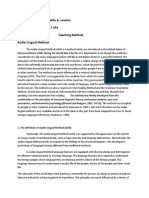Method of Pronunciation
Method of Pronunciation
Uploaded by
Faizal HalimCopyright:
Available Formats
Method of Pronunciation
Method of Pronunciation
Uploaded by
Faizal HalimOriginal Description:
Original Title
Copyright
Available Formats
Share this document
Did you find this document useful?
Is this content inappropriate?
Copyright:
Available Formats
Method of Pronunciation
Method of Pronunciation
Uploaded by
Faizal HalimCopyright:
Available Formats
Pronunciation Teaching
History and Scope
Celce-Murcia, et. al., 1996
1
Review
Basic trends
Two general approaches to the teaching of pronunciation: 1. An intuitive-imitative approach
(before the late 19th century)
Occasionally supplemented by the teachers or textbooks writers impressionistic (and often phonetically inaccurate) observations about sounds based on orthography (Kelly, 1969)
An intuitive-imitative approach (1) depends on the learner's ability to listen to and imitate the rhythms and sounds of the target language without the intervention of any explicit information; (2) presupposes the availability, validity, and reliability of good models to listen to.
2
Review
Basic trends
2. An analytic-linguistic approach
(1) utilizes information and tools such as a phonetic alphabet, articulatory descriptions, charts of the vocal apparatus, contrastive information, and other aids to supplement listening, imitation, and production. (2) explicitly informs the learner of and focuses attention on the sounds and rhythms of the target language.
(3) was developed to complement rather than to replace the intuitiveimitative approach, which was typically retained as the practice phase used in tandem with the phonetic information.
Review
Direct Method
pronunciation is taught through intuition and imitation; students imitate a model - the teacher or a recording - and do their best to approximate the model through imitation and repetition.
First language acquisition Second language acquisition
Naturalistic methods, including comprehension methods that devote a period of learning solely to listening before any speaking is allowed, e.g., Asher's (1977) Total Physical Response and Krashen & Tenell's (1983) Natural Approach.
Proponents maintain that the initial focus on listening without pressure to speak gives the learners the opportunity to internalize the target sound system. When learners do speak later on, their pronunciation is supposedly quite good despite their never having received explicit pronunciation instruction.
4
Review
The Reform Movement
International Phonetic Association founded in 1886 by phoneticians such as Henry Sweet, Wilhelm Vitor, and Paul Passy. International Phonetic Alphabet (IPA) was developed to describe and analyze the sound systems of languages. A phonetic alphabet made it possible to accurately represent the sounds of any language because, for the first time, there was a consistent one-to-one relationship between a written symbol and the sound it represented. The phoneticians, also teachers specifically advocated the following notions and practices:
(1) The spoken form of a language is primary and should be taught first. (2) The findings of phonetics should be applied to language teaching. (3) Teachers must have solid training in phonetics. (4) Learners should be given phonetic training to establish good speech habits.
Review
Audiolingualism / Oral Approach
Audiolingualism in the United States and of the Oral Approach in Britain during (1940s & 1950s),
(1) pronunciation is very important and is taught explicitly from the start (as in the Direct Method classroom, the teacher / recording models a sound, a word, or an utterance and the students imitate or repeat).
(2) the teacher also makes use of information from phonetics, such as a visual transcription system (modified IPA or some other system) or charts that demonstrate the articulation of sounds. (3) the teacher often uses a technique derived from the notion of contrast in structural linguistics: the minimal pair drilldrills that use words that differ by a single sound in the same position. e.g., sheep ship green grin Did you at least get the list?
Review
Audiolingualism / Oral Approach
Audiolingualism in the United States and of the Oral Approach in Britain during (1940s & 1950s),
(3) the minimal pair drilldrills that use words that differ by a single sound in the same position. Types of minimal-pair training (a) Word drills:
sheep ship green grin
(b) Sentence drills: (b-1) Syntagmatic drills (contrast within a sentence)
Dont sit in that seat. Did you at least get the list?
(b-2) Paradigmatic drills (contrast across two sentences)
Don't slip on the floor. (Its wet.) Don't sleep on the floor. (Its cold.)
7
Review
Audiolingualism / Oral Approach
From perception to production: 1. Perception:
(1) Same or different? (Students listening sheep, sheep; ship, sheep) (2) A, B, or C? (Students listening ship; ship; sheep)
2. Oral Production (1) Read down column A, then column B (sheep, green, etc.) (2) Read across the columns (sheep, ship, etc.) Finally, the teacher asks individual students to read the lists without a model.
Review
Cognitive Approach (the 1960s)
The Cognitive Approach, influenced by transformational-generative grammar (Chomsky, 1959,1965) and cognitive psychology (Neisser, 1967), viewed language as rule-governed behavior rather than habit formation. It deemphasized pronunciation in favor of grammar and vocabulary because (1) native-like pronunciation was an unrealistic objective and could not be achieved (Scovel, 1969);
(2) time would be better spent on teaching more learnable items, such as grammatical structures and words.
Review
Cognitive Approach (the 1960s)
The Cognitive Approach, influenced by transformational-generative grammar (Chomsky, 1959,1965) and cognitive psychology (Neisser, 1967), viewed language as rule-governed behavior rather than habit formation. It deemphasized pronunciation in favor of grammar and vocabulary because (1) native-like pronunciation was an unrealistic objective and could not be achieved (Scovel, 1969);
(2) time would be better spent on teaching more learnable items, such as grammatical structures and words.
10
Review
The most commonly used approaches
Various methods and approaches placed pronunciation skill either at the forefront of instruction, as was the case with Reform Movement practices and the Audiolingual/Oral Method, or in the back wings, as with the Direct Method and naturalistic comprehension-based approaches, which operated under the assumption that errors in pronunciation (and other errors, for that matter) were part of the natural acquisition process and would disappear as students gained in communicative proficiency. Other methods and approaches either ignored pronunciation (e.g., Grammar Translation, reading-based approaches, and the Cognitive Approach) or taught pronunciation through imitation and repetition (Direct Method), or through imitation supported by analysis and linguistic information (Audiolingualism).
11
Review
The Silent Way
Like Audiolingualism, the Silent Way (Gattegno, 1972, 1976) can be characterized by the attention paid to accuracy of production of both the sounds and structures of the target language from the very initial stage of instruction. Not only are individual sounds stressed from the very first day of a Silent Way class, but learners' attention is focused on how words combine in phrases - on how blending, stress, and intonation all shape the production of an utterance. Proponents claim that this enables Silent Way learners to sharpen their own inner criteria for accurate production.
The difference between Audiolingualism and the Silent Way is that in the Silent Way learner attention is focused on the sound system without having to learn a phonetic alphabet or a body of explicit linguistic information.
12
Review
The Silent Way
How does the Silent Way work in terms of teaching pronunciation? (1) The teacher speaks as little as possible, indicating through gestures what students should do. (2) It includes an elaborate system in which teachers tap out rhythmic patterns with a pointer, hold up their fingers to indicate the number of syllables in a word or to indicate stressed elements, or model proper positioning of the articulators by pointing to their own lips, teeth, or jaw.
(3) The Silent Way teachers have to use several indispensable tools of the trade such as a sound-color chart, the Fidel charts, word charts, and colored rods.
13
Review
The Silent Way
The sound-color chart was created by Gattegno to bypass the ear (Gattegno, 1985). This large rectangular wall chart contains all the vowel and consonants sounds of a target language in small colored rectangles. In the upper half of the chart are the vowels. The primary vowels are represented by one color each, the diphthongs by two colors. The consonants are located in the bottom half of the chart, and are divided from the vowels by a solid line. The example of Word Chart:
a rod -s -s blue green yellow black brown take red give as to it and not back here her is the them two him an me orange the are one he another these white put end two his
14
Review
The Silent Way: Color & Word Chart
(1) (2) (3) (4) (5)
15
Review
Community Language Learning
Rooted in the humanistic client-centered learning exemplified by Carl Rogers (1951), Community Language Learning (CLL) is a method developed by Charles A. Curran (1976) for teaching second and foreign languages. Students sit around a table with a tape recordera key tool of the method. The counselor (i.e., the teacher) stands behind one of the students, with hands on the student's shoulders. After speaking reassuringly, the counselor asks the student to say something in the native language he or she wishes to be able to say in the target language. This utterance is then provided by the teacher in the target language, who takes care to phrase it idiomatically. The counselor provides the phrase (broken into chunks for ease of repetition), the student repeats, and once the student can produce the whole utterance fluently, it is recorded on tape.
16
Review
Community Language Learning
In the next phase of the lesson, the utterances are played back and students match the new target language with the word-for-word translation provided by the counselor. Next, the teacher asks if the students wish to further practice the pronunciation of any of the new utterances they have learned. If they do, the counselor again stands behind the student who requests further practice and engages in a technique known as human computer. The counselor/computer can be turned on or off at will by the student, who can request the correct pronunciation of a given phrase or piece of a phrase from the computer. This provides the raw data for the student to mimic and repeat until he or she is satisfied with the pronunciation.
17
Review
Community Language Learning
Several tools and techniques are critical to the treatment of pronunciation in CLL. (1) The audiotape recorder not only captures what is said in the studentgenerated utterances but also provides a way for students to distance themselves from what was said, so they can focus on how it was said and compare their pronunciation with that of the counselor. (2) The human computer technique, which gives no overt correction of pronunciation, allows the student to initiate pronunciation practice by selecting the item(s) to practice and deciding the amount of repetition needed. In this way, students are able to approximate the target pronunciation to the extent that they desire. Thus the teaching approach is intuitive and imitative as in the Direct Method, but its exact content and the extent to which practice takes place are controlled by the learner/client rather than the teacher or textbook.
18
Review
Communicative Approach
The Communicative Approach, which took hold in the 1980s and is currently dominant in language teaching, holds that since the primary purpose of language is communication, using language to communicate should be central in all classroom language instruction. This focus on language as communication brings renewed urgency to the teaching of pronunciation, since both empirical and anecdotal evidence indicates that there is a threshold level of pronunciation for nonnative speakers of English; if they fall below this threshold level, they will have oral communication problems no matter how excellent and extensive their control of English grammar and vocabulary might be. (For research supporting this claim, see Hinofotis & Bailey,1980).
19
Review
Communicative Approach
Morley (1987: 2) suggests that there are currently at least four groups of English language learners whose oral communication needs mandate a high level of intelligibility and therefore require special assistance with pronunciation:
1. foreign teaching assistantsand sometimes foreign faculty - in colleges and universities in English-speaking countries 2. foreign-born technical, business, and professional employees in business and industry in English-speaking countries 3. international business people and diplomats who need to use English as their working lingua franca 4. refugees (adult and adolescent) in resettlement and vocational training programs wishing to relocate in English-speaking countries
To Morley's four categories we should add at least two more groups:
5. teachers of English as a foreign language who are not native speakers of English and who expect to serve as the major model and source of input in English for their students 6. people in non-English-speaking countries working as tour guides, waiters, hotel personnel, customs agents, and the like, who use English for dealing with visitors who do not speak their language
20
Review
Communicative Approach
The goal of teaching pronunciation to such learners is not to make them sound like native speakers of English. With the exception of a few highly gifted and motivated individuals, such a goal is unrealistic. A more modest and realistic goal is to enable learners to surpass the threshold level so that their pronunciation will not detract from their ability to communicate. Having established that intelligible pronunciation is one of the necessary components of oral communication, the next issue is methodological: How can teachers improve the pronunciation of unintelligible speakers of English so that they become intelligible? This is a problem for Communicative Language Teaching, since proponents of this approach have not dealt adequately with the role of pronunciation in language teaching, nor have they developed an agreedupon set of strategies for teaching pronunciation communicatively.
21
Review
Communicative Approach
to teach pronunciation. The following is a fairly comprehensive list: 1. Listen and imitate: A technique used in the Direct Method in which students listen to a teacher-provided model and repeat or imitate it.' This technique has been enhanced by the use of tape recorders, language labs, and video recorders. 2. Phonetic training: Use of articulatory descriptions, articulatory diagrams, and a phonetic alphabet (a technique from the Reform Movement, which may involve doing phonetic transcription as well as reading phonetically transcribed text). 3. Minimal pair drills: A technique introduced during the Audiolingual era to help students distinguish between similar and problematic sounds in the target language through listening discrimination and spoken practice. Minimal pair drills typically begin with word-level drills and then move on to sentence-level drills (both paradigmatic and syntagmatic).
22
Review
Communicative Approach
4. Contextualized minimal pairs: Bowen's (1972, 1975b) attempt to make minimal pair drills responsive to Cognitive Approach criticisms of meaninglessness and lack of context. In the technique, the teacher establishes the setting (e.g., a blacksmith shoeing a horse) and presents key vocabulary; students are then trained to respond to a sentence stem with the appropriate meaningful response (a or b) Sentence stem The blacksmith (a. hits; b. heats) the horseshoe. Cued student response a. with the hammer; b. in the fire.
5. Visual aids: Enhancement of the teacher's description of how sounds are produced by audiovisual aids such as sound-color charts, Fidel wall charts, rods, pictures, mirrors, props, realia, etc. These devices are also used to cue production of the target sounds.
23
Review
Communicative Approach
6. Tongue twisters: A technique from speech correction strategies for native speakers (e.g., "She sells seashells by the seashore.")
7. Developmental approximation drills: A technique suggested by first-language acquisition studies in which second language speakers are taught to retrace the steps that many English-speaking children follow as they acquire certain sounds in their first language. Thus just as children learning English often acquire /w/ before /r/ or /y/ before /l/, adults who have difficulty producing /l/ or /r/ can be encouraged to begin by pronouncing words with initial /w/ or /y/, and then shift to /r/ or /l/, respectively:
/w/ --> wed wag witch wipe /r/ red rag rich ripe /y/ --> yet yes you young /l/ let less Lou lung
24
Review
Communicative Approach
8. Practice of vowel shifts and stress shifts related by affixation: A technique based on rules of generative phonology (Chomsky & Halle, 1968) used with intermediate or advanced learners. The teacher points out the rule-based nature of vowel and stress shifts in etymologically related words to raise awareness; sentences and short texts that contain both members of a pair may be provided as oral practice material.
Vowel shift: mime (long /i/) mimic (short /i/) Sentence context: Street mimes often mimic the gestures of passersby. Stress shift: PHOtograph phoTOGraphy
Sentence context: I can tell from these photographs that you are very good at photography.
25
Review
Communicative Approach
9. Reading aloud/recitation: Passages or scripts for learners to practice and then read aloud, focusing on stress, timing, and intonation. This technique may or may not involve memorization of the text, and it usually occurs with genres that are intended to be spoken, such as speeches, poems, plays, and dialogues.
26
Review
Communicative Approach
10. Recordings of learners' production: Audio- and videotapes of rehearsed and spontaneous speeches, free conversations, and role plays. Subsequent playback offers opportunities for feedback from teachers and peers as well as for teacher, peer, and self-evaluation.
27
Review
Communicative Approach
When the Communicative Approach to language teaching began to take over in the mid- to late 1970s (see Brumfit & Johnson, 1979; Widdowson, 1978), most of the aforementioned techniques and materials for teaching pronunciation at the segmental level were flatly rejected on theoretical and practical grounds as being incompatible with teaching language as communication. Influenced by the discourse-based approaches and materials being used to teach language communicatively, materials developers and teachers began to search for more appropriate ways to teach pronunciation. They decided that directing most of their energy to teaching suprasegmental features of language (i.e., rhythm, stress, and intonation) in a discourse context was the optimal way to organize a short-term pronunciation course for nonnative speakers.
28
Review
Communicative Approach
McNerney & Mendelsohn (1992: 186) express this position very clearly: . . . a short term pronunciation course should focus first and foremost on suprasegmentals as they have the greatest impact on the comprehensibility of the learner's English. We have found that giving priority to the suprasegmental aspects of English not only improves learners' comprehensibility but is also less frustrating for students because greater change can be effected in a short time.
29
Review
Communicative Approach
Today we see signs that pronunciation instruction is moving away from the segmental/suprasegmental debate and toward a more balanced view. This view recognizes that both an inability to distinguish sounds that carry a high functional load (such as /i/ in list and /iy/ in least) and an inability to distinguish suprasegmental features (such as intonation and stress differences in yes/no and alternative questions) can have a negative impact on the oral communicationand the listening comprehension abilitiesof nonnative speakers of English. Today's pronunciation curriculum thus seeks to identify the most important aspects of both the segmentals and suprasegmentals, and integrate them appropriately in courses that meet the needs of any given group of learners. In addition to segmental and suprasegmental features of English, there is also the issue of voice quality setting; that is, each language has certain stereotypical features such as pitch level, vowel space, neutral tongue position, and degree of muscular activity that contribute to the overall sound quality or "accent" associated with the language.
30
The End
Comments and suggestions, please!
Thank you!
31
You might also like
- Eng 149 - Language Learning Materials Development HandoutDocument45 pagesEng 149 - Language Learning Materials Development HandoutHanifa PaloNo ratings yet
- English Learning in The Digital Age Agency Technology and Context Shuang Zeng ZDocument217 pagesEnglish Learning in The Digital Age Agency Technology and Context Shuang Zeng ZInday Junaie100% (1)
- A Brief History of Language TeachingDocument7 pagesA Brief History of Language TeachingWilly100% (9)
- (Contemporary Studies in Linguistics) Li Wei, Vivian Cook - Contemporary Applied Linguistics - Volume One Language Teaching and Learning Volume 1 (2009, Continuum) PDFDocument288 pages(Contemporary Studies in Linguistics) Li Wei, Vivian Cook - Contemporary Applied Linguistics - Volume One Language Teaching and Learning Volume 1 (2009, Continuum) PDFMohamed NaceurNo ratings yet
- Overview On PronunciationDocument8 pagesOverview On PronunciationNik ManNo ratings yet
- Language Teachers' Preferences of Pronunciation Teaching Techniques: Traditional or Modern?Document7 pagesLanguage Teachers' Preferences of Pronunciation Teaching Techniques: Traditional or Modern?DumitrescuNo ratings yet
- Oscar Alfredo Torres Apa Audiolingual MethodDocument10 pagesOscar Alfredo Torres Apa Audiolingual Methodoscar-30No ratings yet
- ELT introduction, history and methodsDocument247 pagesELT introduction, history and methodsIvanNo ratings yet
- Course Anthology Phonetics PDFDocument81 pagesCourse Anthology Phonetics PDFMax Arias SeguraNo ratings yet
- Discover Phonetics and Phonology:: A Phonological Awareness WorkbookDocument20 pagesDiscover Phonetics and Phonology:: A Phonological Awareness WorkbookviersiebenNo ratings yet
- Audiolingual Approach PDFDocument26 pagesAudiolingual Approach PDFMohamed abu ajajNo ratings yet
- Radika Mirna Niken 5150511011 Teaching MethodologyDocument4 pagesRadika Mirna Niken 5150511011 Teaching MethodologyRadika MirnaNo ratings yet
- English Pronunciation in L2 Instruction - Chapter 1 2 and 3 - History of Pronunciation Teaching Techniques and Tools AttitudesDocument73 pagesEnglish Pronunciation in L2 Instruction - Chapter 1 2 and 3 - History of Pronunciation Teaching Techniques and Tools AttitudesCarla Palumbo100% (1)
- Utopian Goals For Pronunciation Teaching: Tracey M. DerwingDocument14 pagesUtopian Goals For Pronunciation Teaching: Tracey M. DerwingBrady GrayNo ratings yet
- Methodologies in Foreign Language TeachingDocument8 pagesMethodologies in Foreign Language TeachingSrie Lestary RadityoNo ratings yet
- Communicative Approach vs. Audio-Lingual MethodDocument10 pagesCommunicative Approach vs. Audio-Lingual Methodkitkat1122334480% (5)
- ALM by Hajer and OualaDocument3 pagesALM by Hajer and OualaOuala MaafaNo ratings yet
- Audio Lingual MethodDocument9 pagesAudio Lingual MethodGillaniNo ratings yet
- Nikbakht H. EFL Pronunciation Teaching - A Theoretical Review.Document30 pagesNikbakht H. EFL Pronunciation Teaching - A Theoretical Review.researchdomain100% (1)
- Basic Classification of MethodsDocument5 pagesBasic Classification of MethodsсевинджNo ratings yet
- Bad Pronunciation 2 Gilakjani ANTEPROYECTODocument12 pagesBad Pronunciation 2 Gilakjani ANTEPROYECTOBrady GrayNo ratings yet
- History of English Language TeachingDocument5 pagesHistory of English Language TeachingGabriela RNo ratings yet
- Audio-Lingual Method - WikipediaDocument9 pagesAudio-Lingual Method - WikipediaToqeer TumraniNo ratings yet
- Audio Lingual MethodDocument5 pagesAudio Lingual MethodnurlindaNo ratings yet
- Teaching ListeningDocument26 pagesTeaching ListeningPolly AnnaNo ratings yet
- Audio LingualDocument5 pagesAudio LingualStephen John PalomariaNo ratings yet
- Thornbury Voice-setting phonology 1991Document6 pagesThornbury Voice-setting phonology 1991Enayat LutfiNo ratings yet
- ELTM Kol. 1Document31 pagesELTM Kol. 1KalfanyNo ratings yet
- Cushing_Hellmuth_2016_author_accepted_versionDocument12 pagesCushing_Hellmuth_2016_author_accepted_versionDiana RamjitNo ratings yet
- Linguistic For NETDocument11 pagesLinguistic For NETJaya govinda raoNo ratings yet
- TEFL English Language Teaching MethodologyDocument24 pagesTEFL English Language Teaching MethodologyYour Local MemeistNo ratings yet
- ENG514 Finals Prep by PARAGON'sDocument18 pagesENG514 Finals Prep by PARAGON'sUmer MUHAMMADNo ratings yet
- Situational Language TeachingDocument22 pagesSituational Language TeachingDewars Guillen67% (3)
- ELT - Module2Document17 pagesELT - Module2KrishnaNo ratings yet
- Praca LicencjackaDocument43 pagesPraca LicencjackaNatasza MoskałaNo ratings yet
- Phonology Assignment and Lesson PlanDocument45 pagesPhonology Assignment and Lesson PlanGeroNimoNo ratings yet
- History of Language TeachingDocument4 pagesHistory of Language Teachingneysiisuizavasquez18No ratings yet
- l1 Contemporary Issues in Language Teaching and LearningDocument101 pagesl1 Contemporary Issues in Language Teaching and LearningDAISY MAE EGOSNo ratings yet
- Name: Annisa Bella A. Lawatu Reg Number: A 121 17 243 Teaching Method Audio Lingual MethodDocument4 pagesName: Annisa Bella A. Lawatu Reg Number: A 121 17 243 Teaching Method Audio Lingual MethodAdi Twin RoadNo ratings yet
- Theoretical Background: 2.1 An Introductory NoteDocument16 pagesTheoretical Background: 2.1 An Introductory NotemayoshtyNo ratings yet
- Aufderhaar - PronunciationDocument12 pagesAufderhaar - Pronunciationangelicasmera1No ratings yet
- Chapter 6 TEFl Summary by MeyDocument8 pagesChapter 6 TEFl Summary by MeymikaelaslvrzNo ratings yet
- Rilling (2018)Document7 pagesRilling (2018)Dayang DarmilaNo ratings yet
- Dickey-2003-Imagery For Reɪt Pronunciation (Rightwrite)Document13 pagesDickey-2003-Imagery For Reɪt Pronunciation (Rightwrite)RJDNo ratings yet
- Methods/Approaches of Teaching ESOLDocument12 pagesMethods/Approaches of Teaching ESOLAnglophile123100% (2)
- Audiolingual Method AND Silent Way MethodDocument12 pagesAudiolingual Method AND Silent Way MethodRiani pohanNo ratings yet
- Aural Oral ApproachDocument29 pagesAural Oral ApproachSean Chen75% (8)
- A New Approach To Teaching PronunciationDocument28 pagesA New Approach To Teaching PronunciationflorentynaforworkNo ratings yet
- The Oral Approach and Situational Language TeachingDocument51 pagesThe Oral Approach and Situational Language TeachingSussanRoo100% (1)
- TEMA 1 Oposición Profesor Inglés 2021Document8 pagesTEMA 1 Oposición Profesor Inglés 2021Álvaro HPNo ratings yet
- Integration Not Eclecticism - A Brief History of Language Teaching, 1853 - 2003Document9 pagesIntegration Not Eclecticism - A Brief History of Language Teaching, 1853 - 2003YanNo ratings yet
- Cushing Hellmuth 2016 Author Accepted VersionDocument12 pagesCushing Hellmuth 2016 Author Accepted VersionPaulaNo ratings yet
- Litriture Main-1Document67 pagesLitriture Main-1gardia1261No ratings yet
- The Oral Approach and Situational Language TeachingDocument51 pagesThe Oral Approach and Situational Language TeachingBeck Cky67% (3)
- WEEK 3 Resources ForDocument10 pagesWEEK 3 Resources ForHanoveraNo ratings yet
- Chapter 3 Audio-Lingual MehthodDocument19 pagesChapter 3 Audio-Lingual Mehthodbawari.mangal525No ratings yet
- Oral Situational U3t1Document25 pagesOral Situational U3t1Elda Melissa García RetamaNo ratings yet
- Grammar Toolkit: A Stellar Guide to Language ExplorationFrom EverandGrammar Toolkit: A Stellar Guide to Language ExplorationNo ratings yet
- University Level English Speaking: Navigating English Communication with ConfidenceFrom EverandUniversity Level English Speaking: Navigating English Communication with ConfidenceNo ratings yet
- Pronunciation in EFL Instruction: A Research-Based ApproachFrom EverandPronunciation in EFL Instruction: A Research-Based ApproachRating: 3.5 out of 5 stars3.5/5 (2)
- Vocabulary Learning Strategies and Foreign Language AcquisitionFrom EverandVocabulary Learning Strategies and Foreign Language AcquisitionRating: 2 out of 5 stars2/5 (8)
- Jadual KelasDocument2 pagesJadual KelasFaizal HalimNo ratings yet
- RPH Year 5Document6 pagesRPH Year 5Faizal HalimNo ratings yet
- Developing Classroom SkillsDocument15 pagesDeveloping Classroom SkillsFaizal HalimNo ratings yet
- Practical 2...Document9 pagesPractical 2...Faizal HalimNo ratings yet
- AKTVT&AMALIDocument7 pagesAKTVT&AMALIBok BongNo ratings yet
- ElectrolysisDocument16 pagesElectrolysisFaizal HalimNo ratings yet
- Test For Reducing SugarsDocument3 pagesTest For Reducing SugarsFaizal Halim100% (1)
- Glass FibreDocument8 pagesGlass FibreFaizal HalimNo ratings yet
- The Dynamics of Using Argumentation in The EFL ClassroomDocument5 pagesThe Dynamics of Using Argumentation in The EFL Classroomwaqarali78692No ratings yet
- 0 TOEIC Answer Sheet - PlantillaDocument1 page0 TOEIC Answer Sheet - PlantillaestefaniaNo ratings yet
- Lam PT-03-01-TSLB3303Document5 pagesLam PT-03-01-TSLB33031381-15-manojkumarNo ratings yet
- Which School?: Reading and Writing Portfolio 5Document2 pagesWhich School?: Reading and Writing Portfolio 5Geans C. Huaynates VargasNo ratings yet
- The Structural-Situational ApproachDocument16 pagesThe Structural-Situational ApproachTấn Tài VõNo ratings yet
- ESP - Ch7 - Assessment and Testing in ESPDocument30 pagesESP - Ch7 - Assessment and Testing in ESPبطانية ’ سانNo ratings yet
- Improving Students' Vocabulary Using Card Game (An Action Research at The Fifth Year of SD Negeri Sedayu I Slogohimo)Document7 pagesImproving Students' Vocabulary Using Card Game (An Action Research at The Fifth Year of SD Negeri Sedayu I Slogohimo)brionesjhonkierNo ratings yet
- Accepted Tests of English ProficiencyDocument1 pageAccepted Tests of English ProficiencypraveenNo ratings yet
- 02.0 PP II II The Cambridge Applied Linguistics SeriesDocument4 pages02.0 PP II II The Cambridge Applied Linguistics SeriesvietdungnhuthaoNo ratings yet
- University of Eastern Philippines Langlit806: Methodology of Language Teaching Rey Jazmin Mananguete Prof. Kristine Mae B. Destura, DALLDocument2 pagesUniversity of Eastern Philippines Langlit806: Methodology of Language Teaching Rey Jazmin Mananguete Prof. Kristine Mae B. Destura, DALLRey ManangueteNo ratings yet
- Kinds of ELT SyllabusDocument5 pagesKinds of ELT Syllabusazan000012310No ratings yet
- Ce Schools PresentationDocument24 pagesCe Schools Presentationsnjv0601No ratings yet
- Hyland (2014)Document15 pagesHyland (2014)KSOR RCOM H' LYYANo ratings yet
- Ga10 Hoan ChinhDocument138 pagesGa10 Hoan Chinhkimtuandl1982No ratings yet
- Course Syllabus in Language Education ResearchDocument6 pagesCourse Syllabus in Language Education ResearchGlenn Jerry CastilloNo ratings yet
- Jacqueline Gollin-Key Concepts in ELTDocument2 pagesJacqueline Gollin-Key Concepts in ELTmsNo ratings yet
- Grade 6 Dec Holiday BookletDocument113 pagesGrade 6 Dec Holiday Bookletkevinmongare265No ratings yet
- Jon Reyhner, Gina Cantoni, Robert N. St. Clair, E Revitalizing Indegenous LanguagesDocument161 pagesJon Reyhner, Gina Cantoni, Robert N. St. Clair, E Revitalizing Indegenous LanguagesRatnasiri ArangalaNo ratings yet
- Mentors' Communicative Competence Related To LET Performance of English Majors: Inputs To The Development of A Contextualized Upskilling ProgramDocument8 pagesMentors' Communicative Competence Related To LET Performance of English Majors: Inputs To The Development of A Contextualized Upskilling ProgramPsychology and Education: A Multidisciplinary JournalNo ratings yet
- Werner 2020Document33 pagesWerner 2020annakrokhmalNo ratings yet
- Claire Ross Integrating Skills FinalDocument17 pagesClaire Ross Integrating Skills FinalMilaNo ratings yet
- Iesol L2/C1 Listening and Reading Answer Sheet - Hippo Sample Task 1Document2 pagesIesol L2/C1 Listening and Reading Answer Sheet - Hippo Sample Task 1Nisa ShaqiriNo ratings yet
- Discourse Analysis Syllabus: Course InformationDocument3 pagesDiscourse Analysis Syllabus: Course InformationBenjamin L. StewartNo ratings yet
- BC Regional Policy DialoguesDocument116 pagesBC Regional Policy DialoguesolivierNo ratings yet
- Teaching Functional Grammar in IsolationDocument6 pagesTeaching Functional Grammar in IsolationZul Aiman Abd WahabNo ratings yet
- Solved Assignment 6472 by WaheedDocument10 pagesSolved Assignment 6472 by WaheedWaheed AhmedNo ratings yet
- What Is ESP - HumanitiesDocument14 pagesWhat Is ESP - HumanitieslaifkaifNo ratings yet

































































































